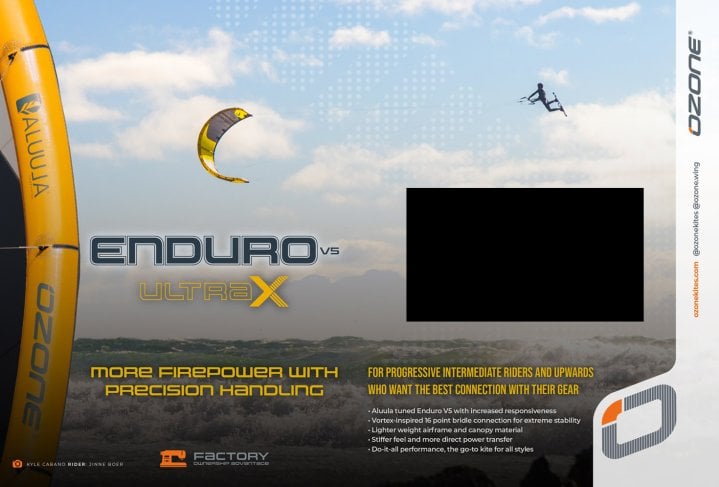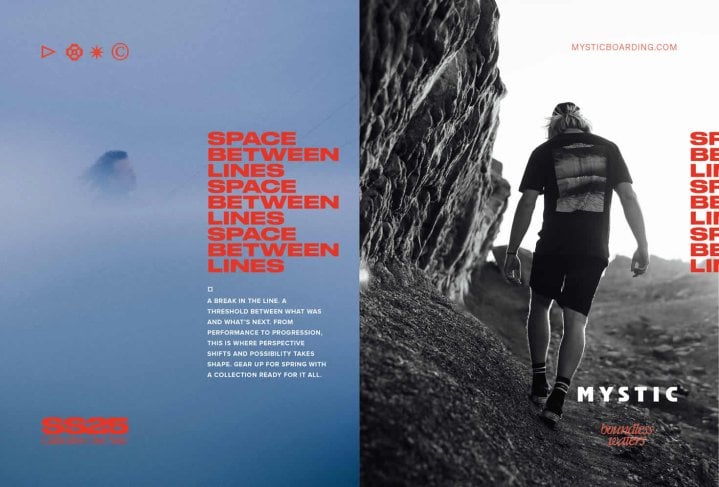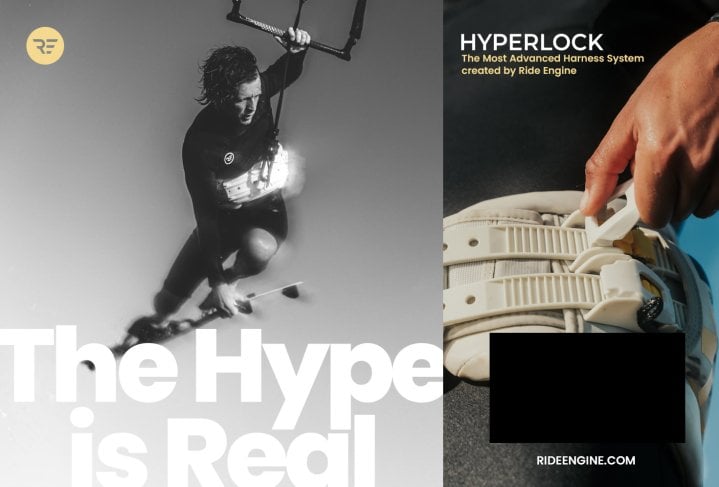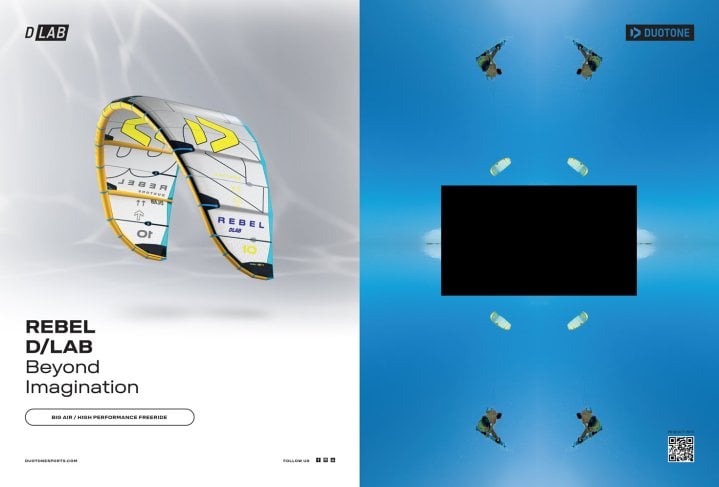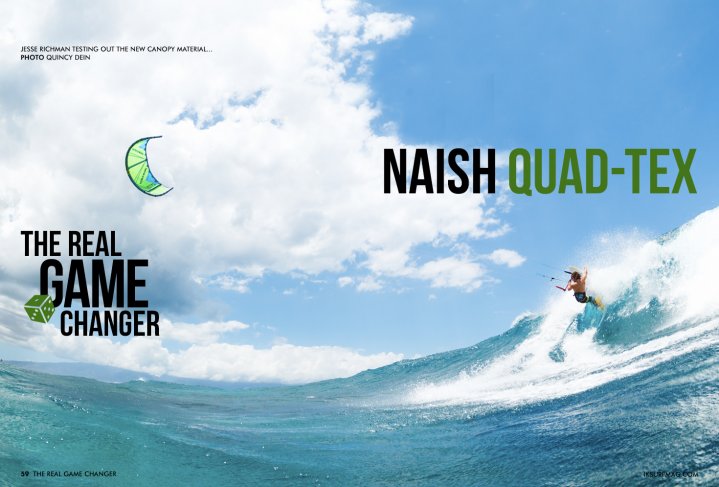
The Real Game Changer - Naish
Issue 59 / Thu 13th Oct, 2016
Imagine a world where your kite not only lasted a few seasons but kept its performance for that period of time too. Quad Tex claims to not only improve the handling of your kite out of the bag; it will keep it flying like new for years to come.
Kite materials have improved dramatically in recent years, you can now get a couple of seasons use from a kite and still sell it on in good condition. A couple of years ago the new D2 Teijin canopy fabric was introduced, making kites stiffer and last even longer. Naish have just taken the next step along that road with the development of their Quad-Tex material. Stronger, stiffer materials can make a kite more responsive, but they can also make a kite last a lot longer too, saving on wastage and the need for you to dip into your pocket every couple of years. We chatted to Damien Girardin about the new material and what led them to take canopy material to the next level.
First, it was North, then Core with triple ripstop, now you guys have gone for Quad, what’s the benefit of adding these strands to the canopy material?
Damien Girardin: Well, I can’t speak for North or Core, as it seems like they were going after a different goal than we were. North, for example, has been claiming an added durability and prevention from rips. On our side, the increased durability and rip prevention was secondary and came with the nature of the material.
The very first goal was to increase stiffness and longevity of the canopy material. Increasing the stiffness of the canopy makes your kite respond faster to bar input and wind gusts, making your kite so much more direct and fun to ride. “Faster turning”, “more direct” and “more crisp” are few of the key characteristics that most people are feeling on kites made out of Quad-Tex.
Finally, our long-term (3 years) testing has proven that these characteristics continue to deliver responsive performance longer on a Quad-Tex kite and, over time, will still feel superior to a kite made out of other canopy materials. This is because with Quad-Tex you rely less on the resin of the material to provide the stiffness. Instead, these characteristics come from the very nature of the core of the canopy itself.
Why not just beat everyone else to it and go for Octo Tex? This seems like the razor wars that started out with one blade, went to two, then three then five. Everyone one-upping each other, what was behind the number four?
Instead of starting with a material and adding ripstop yarns to it, I looked at it the other way around. I started off with a matrix of ripstop yarn (typically 3x stronger than the rest of the yarn in the material) that would give superior characteristics to the material and then added the “regular” yarn in between this matrix to complete the material —4 of these yarns turned out to be the right number.
Did you develop the material with anyone else, Teijin or one of the other canopy material factories, or was it done in house?
The material was a full-on collab with Teijin, our partner for many years already. Working with Teijin was a key to the success of the project. They are the best of the best, and their quality is just irreproachable. Their attention to detail is unparalleled, and the result of this 3-year long development process has turned out even better than I’d expected!
Have you patented it? Will it be something we will see other brands start to use?
We do not have a patent for Quad-Tex. However, only Teijin can make it, and we have a one-year exclusivity agreement on the material use.
Obviously, the Quad Tex makes for a stiffer stronger material, how does that effect the flying characteristics of the kite, did you have to change the shapes and layouts of the panels to still achieve decent twist in the kite to improve the handling?
The main thing, as you stated, is that the material is stiffer, which makes for a more reactive kite. At the same time, the material is also stronger, which enabled me to reduce some of the extra reinforcements that we had on the kites in the past, which ended up reducing weight on the kites as well.
Aside from the extra strands in the material what else is different about it?
Apart from the 30% increase in strength compared to the best materials on the market, Quad-Tex also exhibits the least amount of elongation and stretch—consistently outperforming competitors in warp and weft tests. Simply stated, Quad-Tex will last longer and our testing for over three years has shown that a 1-year-old Quad-Tex kite is still stiffer than a brand new kite made from other leading materials.
What was the biggest challenge in the development process?
The biggest challenge was to learn how to work with such a big industrial manufacturer, where a sample takes about six months to be made. I’m used to having kite prototypes ready about a week after I design them! It was definitely an entirely new and different approach for me. Organising the long-term testing of the material was also challenging since I had to spend long hours kiting and crashing in the waves!
How does Quad Tex benefit the consumer and why should they buy it?
Quad-Tex makes a better, stiffer, more reactive kite that will last longer—indeed, it keeps value for a longer time. I think that once you’ve tried our Quad-Tex kites and felt the difference, there is no going back to the other designs and materials.
Videos
By Rou Chater
Rou has been kiting since the sports inception and has been working as an editor and tester for magazines since 2004. He started IKSURFMAG with his brother in 2006 and has tested hundreds of different kites and travelled all over the world to kitesurf. He's a walking encyclopedia of all things kite and is just as passionate about the sport today as he was when he first started!


